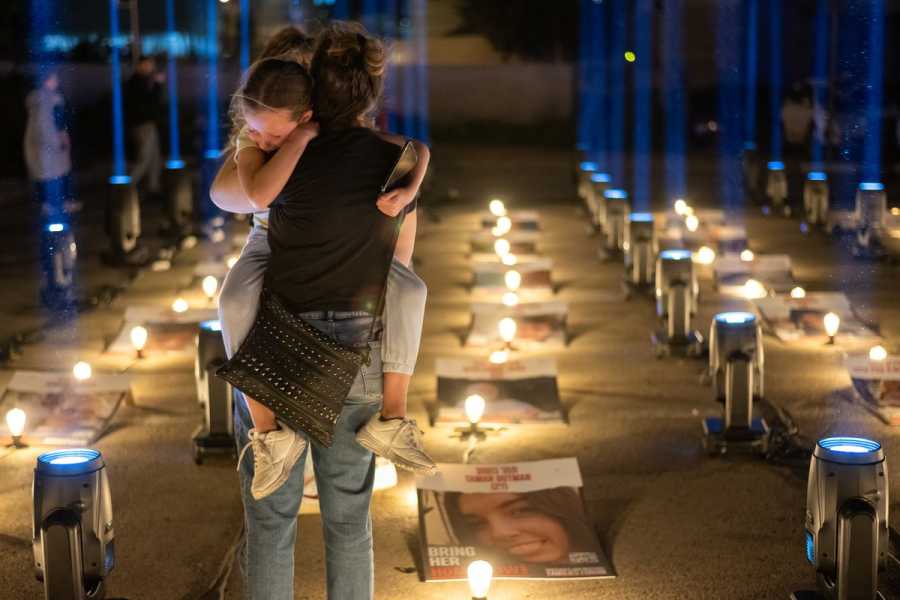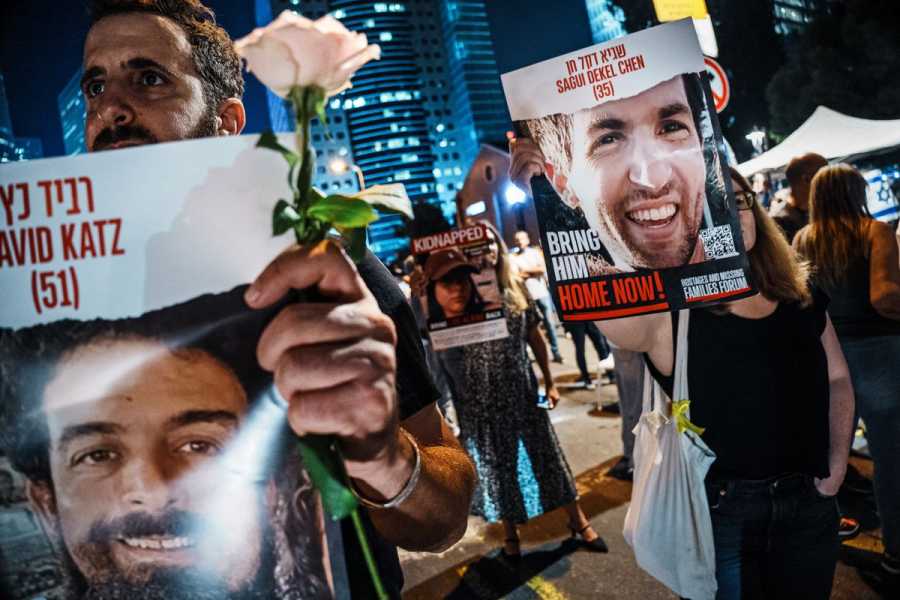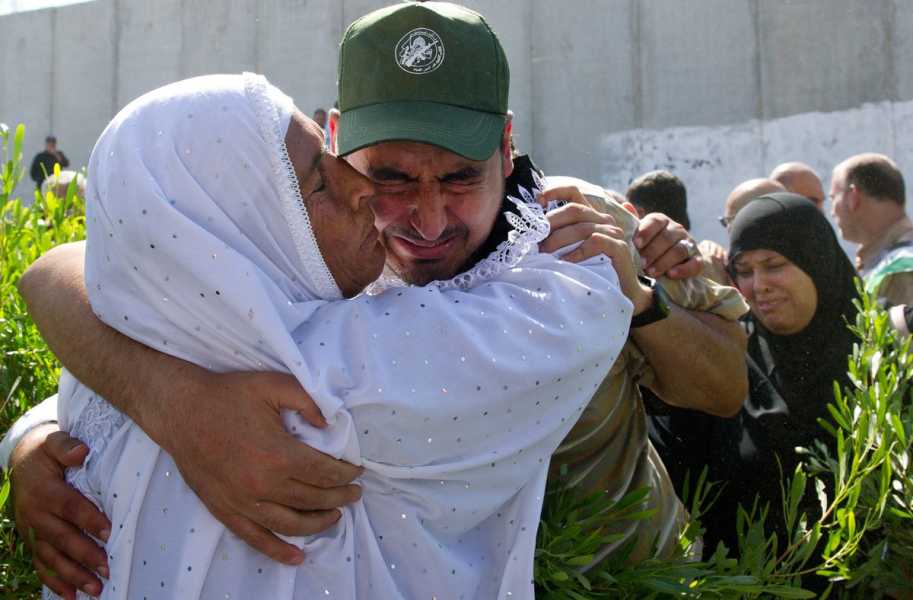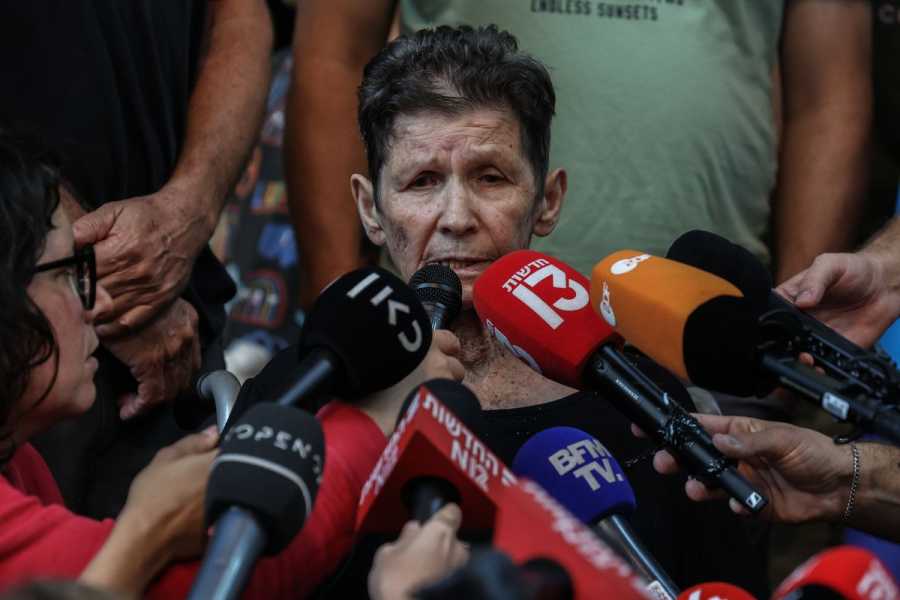More than 200 people were taken hostage by Hamas. Here’s what we know.

Families and friends of hostages cry and embrace while visiting the Lights of Hope installation featuring photos of the hostages on October 30, 2023, in Jerusalem, Israel. Alexi J. Rosenfeld/Getty Images Li Zhou is a politics reporter at Vox, where she covers Congress and elections. Previously, she was a tech policy reporter at Politico and an editorial fellow at the Atlantic.
Pressure is mounting on the Israeli government to find a way to retrieve over 200 hostages currently held by the Palestinian militant group Hamas as the Israeli Defense Force’s ground offensive into Gaza increases in intensity. Five hostages have now been freed — four released recently by Hamas, and one rescued during the Israeli ground assault.
As the hostages’ captivity stretches on, however, divides are becoming apparent both within Israel and among its partners. Families of the hostages have called on Prime Minister Benjamin Netanyahu to consider an “all for all” exchange — trading every hostage taken by Hamas for every Palestinian prisoner held by Israel. Israeli officials have said they haven’t completely ruled out the proposal, but that they believe a military offensive is the best strategy right now. Netanyahu reiterated in a speech on Monday that he believes the ongoing “ground action” by Israel will create the possibility of hostage rescue, like the successful retrieval of an IDF soldier this week.
“Hamas will not do it unless they are under pressure,” Netanyahu said.
The impasse follows a brutal attack by Hamas on Israel on October 7, during which it’s estimated to have killed 1,400 civilians in addition to the hostages it captured. After that incursion, the Israeli government retaliated by conducting devastating airstrikes on Gaza, restricting food, water, and fuel to the people who live there, and launching a ground invasion some observers fear could lead to a wider conflict.
The violence in Gaza has killed over 8,000 people, most of whom were civilians, according to the Gaza Health Ministry. Hamas has also claimed that nearly 50 hostages have been killed in Israeli airstrikes, a figure that hasn’t been independently verified. One German Israeli woman previously believed to have been taken hostage has been confirmed to have been killed, though it is unclear exactly when and how she died.
There’s a lot that’s still uncertain about the steps Hamas could take next and its approach to negotiations. Given the situation so far, and the group’s past practices, however, here’s what we do know about who the hostages are, what Hamas wants, and which parties have been involved in talks.
Who are the hostages?
The hostages include more than 200 people who were captured by Hamas in Israeli border towns, at an outdoor music festival, and at military bases on October 7. They include many civilians of different ages — including older adults, a 9-month-old baby, and children — as well as military service members, according to the New York Times.
More than half of the hostages are believed to have foreign passports and reportedly come from 25 different countries, including Thailand, the US, Argentina, France, Germany, and Russia, according to the Israeli government.
The families of hostages have fought to keep their loved ones a top priority in the ongoing Israel-Hamas conflict, with some forming an organization called the Hostages and Missing Families Forum, which is dedicated to pushing for their return.
“I’m telling my government — I don’t care what the price is, you have to pay it,” Lior Peri, the son of one of the hostages, told the Financial Times. “We are making sure that nobody forgets the kidnapped and missing people. The women, children, the elderly,” Meirav Gonen, whose daughter is believed to have been taken hostage, told the National Post. “We must keep this issue at the forefront, not just in our country but around the world.”
Gonen said her daughter, Romi, 23, is someone who “loves people’’ and “is just getting to know the world.” She’s among the hostages that were thought to have been taken from the music festival.
“[I] told her how much I love her and how much she’s loved, and what we will do when she comes back home,” Gonen told the AP about the last conversation they had.

Protesters demonstrate in Tel Aviv on October 24, calling for the release of hostages. Marcus Yam/Los Angeles Times/Getty Images
Michael Levy’s brother, Or, 33, is also among the captives and someone he describes as a brilliant computer programmer who is “always smiling, always happy.”
Levy’s parents told the AP that Or’s 2-year-old son has been asking for his parents, including his mother who was killed in the October 7 attacks, for the past two weeks. Adva Adar’s grandmother Yaffa Adar, 85, was taken hostage on October 7 and is the “glue of our family,” Adva told the AP.
Many family members have stressed the importance of bringing the hostages back home and urged the Israeli government to do more. “I want him back now…to his home,” Miri Benami told Al Jazeera, about her 24-year-old son Yosef, who is believed to have been kidnapped by Hamas.
Three of the hostages — Yelena Trupanob, Danielle Aloni, and Rimon Kirsht, according to Netanyahu — have appeared in a video released by Hamas, though it’s unclear if the message they delivered was one of their own or something crafted by the group. Only Aloni speaks in the clip; her remarks blame Netanyahu and his government’s “political, military, and security failure,” and advocate for Israel to release all Palestinian prisoners in exchange for those held in Gaza.
Why did Hamas release a few of its hostages?
The hostages Hamas has released so far are Judith Ranaan, 59, and Natalie Ranaan, 17, an American mother and daughter; and Yocheved Lifshitz, 85, and Nuri Yitzhak, 79, two Israeli citizens. During its ground offensive, Israel also freed IDF Pvt. Ori Megidish as part of what its officials described as a special operation.
Hamas has said that it decided to release its first hostages based on “humanitarian” reasons, a claim that hostage experts dismiss because the act of taking hostages is a war crime, a violation of the Geneva Conventions, and a continuation of brutal actions the group has taken.
More likely, Hamas’s decisions are based on trying to improve its image and attempting to demonstrate that it’s a legitimate partner in negotiations, says Christopher O’Leary, the former director of hostage recovery for the US government and a senior vice president for the Soufan Group.
If the group continues to let hostages go, it could release civilians in batches, O’Leary theorized. And if it follows a pattern Palestinian militant groups have used in the past, Hamas has probably organized the hostages into groups based on different characteristics — like whether they are civilians, foreign nationals, or service members. Hamas will probably keep Israeli soldiers the longest because they see them as key leverage for potential prisoner exchanges or other longer-term demands, O’Leary guessed.
“If I was to speculate, I would say the next group to come out would be women and children, because it [attempts to put] them on higher ground compared to the Israelis in the global community and public perception,” says O’Leary, who notes that Hamas may want to draw a contrast with the Israeli government’s actions in Gaza, including airstrikes that have killed thousands of children.
O’Leary also anticipated that Hamas would keep foreign nationals and stagger their releases because it helped to maintain pressure on different countries’ governments. It’s worth noting that there’s still a lot that we don’t know about how the group may approach international or Israeli captives, however. In a visit to Moscow following the attack, a Hamas spokesperson Abu Marzouk told a Russian state news outlet that the hostages’ nationalities were less relevant when it comes to negotiations: “All those captured, for us, are Israelis.” Marzouk stressed Hamas wouldn’t release foreign hostages unless there was an agreement for a ceasefire.
What is Hamas’s history of taking hostages?
Hamas’s recent actions are in line with Palestinian militant groups’ history of using hostage-taking as a tactic to draw attention to their cause and to increase leverage in negotiations with Israel. Previously, there have been multiple instances of groups including Hamas taking hostages. In 2006, Hamas kidnapped Israeli soldier Gilad Shalit, ultimately exchanging him for 1,027 Palestinian prisoners in 2011.

Jalal al Loh, one of the Palestinians freed in exchange for Gilad Shalit, returns to Gaza in 2011. Lynsey Addario/Getty Images
The group also captured and killed Israeli soldiers in 1989 and 1994, spurring a wave of Israeli arrests of Hamas members. And in 2014, Hamas kidnapped and killed three Israeli teenagers, who the group had at one point hoped to trade for Palestinian prisoners. That time, Israel responded with hundreds of arrests including that of a number of Hamas leaders, and the incident fueled tensions between the two groups that contributed to the 2014 Gaza war.
“Starting in the 1960s, and throughout the 1970s, a handful of different Palestinian militant organizations used mostly airplane hijackings to take big groups of Israelis hostage, and to demand prisoner releases and prisoner exchanges and other concessions from the Israeli government,” says Northwestern University political scientist Danielle Gilbert, a professor who studies hostage-taking practices. “Fast-forward to the 1980s, when militant organizations in the region started using kidnapping as a specific form of hostage-taking violence, rather than using airplane hijackings.”
Gilbert says that Hamas’s decision to take hostages is a continuation of these prior practices and also a continuation of the group’s alleged efforts to use civilians as “human shields.” Hamas has often been accused by Israel of locating its bases or launching weapons in Gaza near or in residential areas. Recently, Israel claimed Hamas’s headquarters is located under one of Gaza City’s main hospitals, for example, an accusation Hamas has refuted. In this case, Hamas could be using the presence of hostages in Gaza’s tunnels to protect its operatives.
In the days immediately following the October 7 attack, Hamas threatened to kill a civilian hostage every time Israel targeted Gaza civilians with airstrikes “without warning,” though it has not repeated that claim in the weeks since.
Overall, it’s difficult to say exactly how this hostage situation will play out given how different it is from Hamas’s past practices, and how much we don’t know. The group currently being held is one of the largest number of hostages Hamas has ever taken, and is unusual because it includes such a wide range of civilians, in addition to service members.
What does Hamas want in exchange for the hostages? What is its longer-term strategy?
Hamas likely has short- and long-term demands related to the hostages — including some it’s publicly expressed.
Hamas is calling for more humanitarian aid to be distributed in Gaza in exchange for the release of additional hostages in the near term. That aid includes food, water, and fuel, the last of which has proven to be a barrier to an agreement due to Israeli government concerns that it could be used to supply rockets and more attacks. Hamas has also reportedly demanded a ceasefire in exchange for the release of more hostages, according to the Wall Street Journal.
Israel claims Hamas has plenty of fuel to supply the people of Gaza with. So far, according to the UN, roughly 12 trucks of aid per day are being allowed into Gaza, down from the roughly 500 a day that brought goods before the siege.
Another of Hamas’s demands is the release of Palestinian prisoners who’ve been jailed by the Israeli government. There are an estimated 5,000 Palestinian prisoners in Israeli jails, including Hamas militants. “The price to pay for the large number of enemy hostages in our hands is to empty the prisons of all Palestinian prisoners,” Hamas spokesperson Abu Obeida said in a statement.
How are the hostages being treated?
The hostages released so far have shared narratives with the public both directly and indirectly.
Lifshitz, one of the older adults set free, has spoken about the harrowing experience of being kidnapped and held captive in one of Hamas’s Gaza tunnels. She says she was beaten during the kidnapping in her kibbutz of Nir Oz and driven away on a motorbike. “I went through hell,” she said of the abduction.
Lifshitz then recalls walking into a maze of tunnels that she describes as a “spiderweb” and being grouped with a handful of others from her kibbutz in an area where they all slept on mattresses. She says that members of Hamas said “they believe the Quran and they will not harm us.” Lifshitz also said she received food and medical care while in captivity, and was treated “gently” during that time.

Yocheved Lifshitz speaks to the press following her return to Israel in October 2023. Ilia Yefimovich/DPA/Picture Alliance/Getty Images
The Ranaans’ family members have also spoken out about their capture and reunion, describing how their family was held up at gunpoint while waiting on their kitchen floor. According to Good Morning America, 13 members of their family had either been kidnapped or killed during the October 7 attack, and they were still waiting to hear about the status of many of them.
Megidish has not spoken out publicly, but according to the IDF she is “doing well.”
O’Leary says he suspects that Hamas will want to treat the hostages well, both to keep them alive, and so when they are released, their narratives will help soften Hamas’s image on the world stage following the violent killings and kidnappings it carried out on October 7.
“This is for an eventual transaction,” he notes. “So you want to keep [them] healthy, well fed, of relatively decent health, sound of mind.”
He added that it was not “out of the question” that Hamas could harm or kill hostages if the situation worsened, but said it was “unlikely” because the group is interested in maintaining the broader global support that Palestinian rights have gained.
Who are the key international players here and why?
The main parties involved in these negotiations are the Israeli government, Hamas, Qatar, Egypt, and the US. Thus far, Qatar and Egypt have played a key role in mediating the negotiations between Hamas, and the Israeli and US governments, as both countries have relationships with all three parties. The US has no diplomatic ties with Hamas, which it considers a terrorist group.
Qatar is home to a Hamas office and has provided millions of dollars in aid to Gaza. Additionally, it has had strong ties with both the US and Israel. The country was an important party in the release of American hostages in Afghanistan as well as in Mali and Niger, O’Leary notes. Egypt also has back channels with Hamas, which it’s previously negotiated ceasefires with as well.
“Often in ransom kidnappings … the hostage taker makes the demand, the target responds with a much lower counteroffer over a long period of time, and they keep whittling away at each other’s positions until they find a point that they can agree on,” says Gilbert of how the process may work. “And sometimes if we’re thinking about prisoner swaps, it might be a protracted effort on both sides to figure out the number and the kind of people that each side is willing to release in exchange for getting their person or their people home.”
Exactly how much more Qatar and Egypt will be able to accomplish is unclear. Israeli leaders have explicitly stated they feel a military strategy is the best way to free more hostages, while some of Hamas’s demands — as noted above — have initially been rejected by Israel’s leaders.
What’s the most effective way to secure hostages’ release?
The Biden administration reportedly discussed and decided against trying to rescue Hamas’s hostages in a US military operation, a decision that appears to weigh key risks hostage experts have cited.
“Across countries and over time, the best way to recover hostages has always been through negotiations,” Gilbert says, “which has a higher likelihood of bringing hostages out of captivity alive.” While the approach is dependent on the circumstances, including the immediate threat that hostages face, negotiations can minimize the risk both to hostages as well as to special forces that might be involved in a rescue effort.
The downside of negotiation is how time-consuming the process can be as well as the precedent such talks could set for rewarding hostage-takers for “egregious unlawful behavior,” Gilbert notes.
Attempts at hostage rescue, meanwhile, are often riskier. These types of missions are typically conducted by special forces operations on the ground, but are dependent on knowing the precise locations of hostages. In this case, a mission like this is even more complex given the number of hostages and the belief that they are spread out in a difficult-to-navigate series of tunnels.
“For you to do a successful hostage rescue, you need intelligence and information at a granular level,” says O’Leary, of the data that’s typically required to mount a rescue mission. While the US and its allies have strong data-gathering capabilities, it isn’t clear its military — or Israel’s — has sufficient intelligence to effectively rescue all of the hostages without increasing the risks they face.
Israeli leaders have repeatedly argued military action is the most effective way to pressure Hamas into releasing more hostages. Some of the hostages’ families question that approach, however, expressing concern that military operations risk further harming the hostages in crossfire or via reprisals.
“We came with an unequivocal demand that military action takes into account the fate of the hostages and the missing, and that any move considered will take into account the well-being of our loved ones,” Gonen said regarding a meeting between families of hostages and Israeli officials.
Israeli government officials have said they are focused on pursuing all the channels available, but that it views military action as central.
“The more military pressure, the more firepower, and the more we strike Hamas — the greater our chances are to bring it to a place where it will agree to a solution that will allow the return of your loved ones,” Israeli defense minister Yoav Gallant has said.
Sourse: vox.com